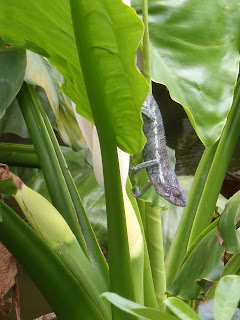So I’ve been meaning to do a post on chameleons, about 50%
of which are native to, and found only on, the island of Madagascar. I have
seen a variety of colorful chameleons here and wanted to share the pictures and
some fun facts with you!
They are able to change colors because their skin has little sacs of pigment called chromatophores, that expand or contract based on certain stimuli. Here, this chameleon is displaying a blue countenance.
I learned from cartoons as a kid that chameleons change
color to match their background, but this is actually untrue; they change color
mainly to express emotion, or to attract a mate. This red fellow below is
strutting his stuff and advertising himself as looking for a lady—and red is a
very obvious visual signal against the green backdrop of the forest.
They are able to change colors because their skin has little sacs of pigment called chromatophores, that expand or contract based on certain stimuli. Here, this chameleon is displaying a blue countenance.
As mentioned in a previous post, some chameleons turn white
while they sleep, which makes them very easy to find: they usually sleep at the
ends of branches around my eye level.
I took this photo as this individual woke up, and he is mid-
color change, see how he is still whitish along his belly.
Here is another sleepy chameleon of a different species (Calumma spp., previous ones all Furcifer spp.) that stayed green while
he slept.
When we first found this little guy, we thought he might be
a Brookesia, the world’s smallest
chameleon and in fact the world’s smallest vertebrate, but he is actually an infant
of the Calumma genus.
Chameleons walk very slowly, as if to emulate a leaf
rustling on a branch, using their claw-like feet and prehensile tail. This
makes them easy to catch!
One of the coolest things about a chameleon is its eyes: chameleons
have a 360 degree visual field and can rotate each eye independently.









Love this post!!! I love chameleons and I love Katie :)
ReplyDelete